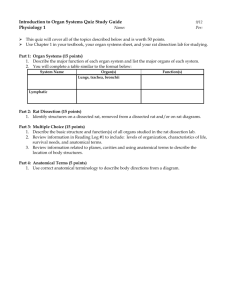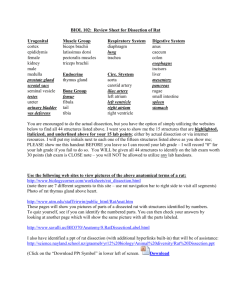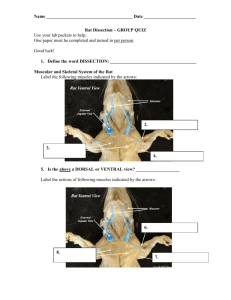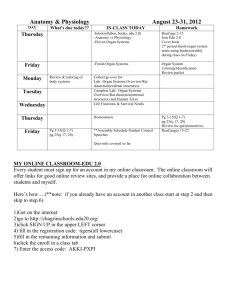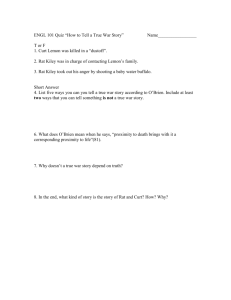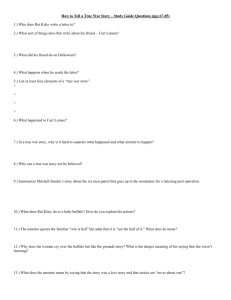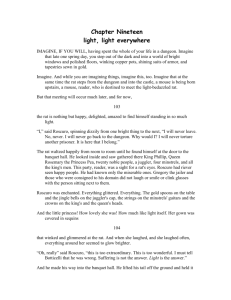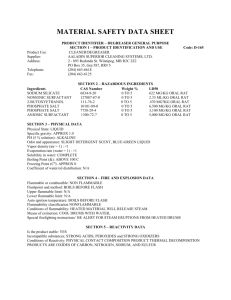Rat Dissection Lab Worksheet
advertisement
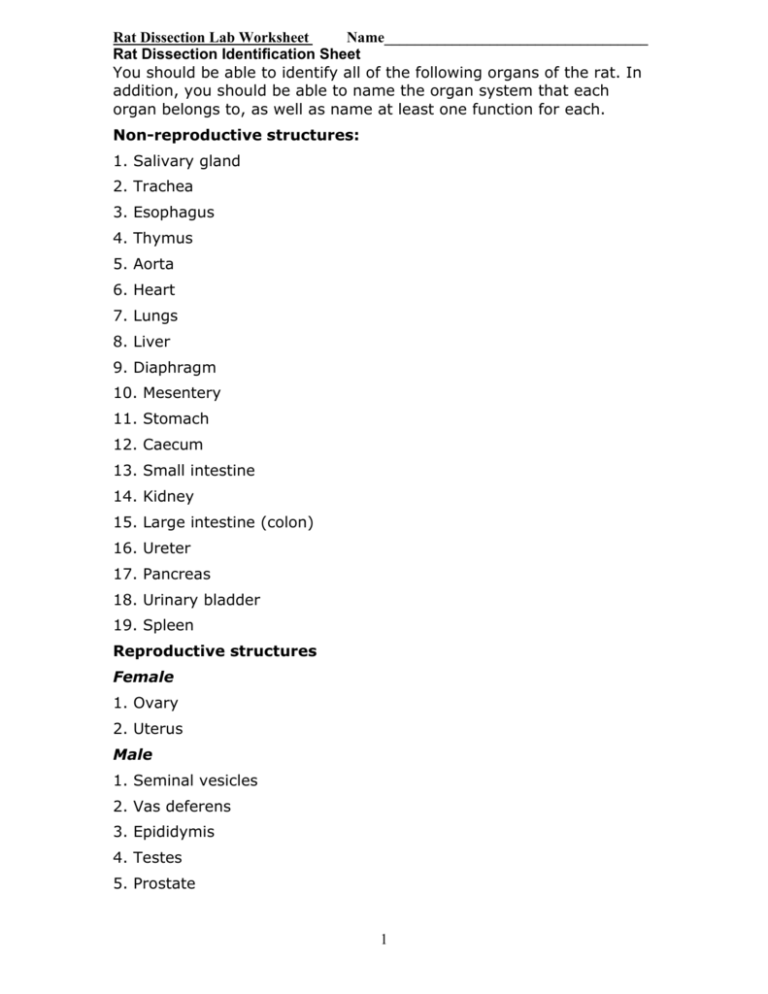
Rat Dissection Lab Worksheet Name___________________________________ Rat Dissection Identification Sheet You should be able to identify all of the following organs of the rat. In addition, you should be able to name the organ system that each organ belongs to, as well as name at least one function for each. Non-reproductive structures: 1. Salivary gland 2. Trachea 3. Esophagus 4. Thymus 5. Aorta 6. Heart 7. Lungs 8. Liver 9. Diaphragm 10. Mesentery 11. Stomach 12. Caecum 13. Small intestine 14. Kidney 15. Large intestine (colon) 16. Ureter 17. Pancreas 18. Urinary bladder 19. Spleen Reproductive structures Female 1. Ovary 2. Uterus Male 1. Seminal vesicles 2. Vas deferens 3. Epididymis 4. Testes 5. Prostate 1 Introduction 1. What is the scientific name of the rat you are dissecting?____________________________ 2. What are these 2 scientific categories?___________________________ 3. What is the common name of this rat?_________________________________ 4. What “family” does this rat belong to?______________________________ 5. What other rodents belong in this family?___________________________________________ 9. Why is the rat a good dissection specimen, when you need to learn about human anatomy? ______________________________________________________________________________ External Anatomy 1. Toward the bottom or belly=__________________ 2. Toward the tail=____________________________ 3. Toward the top or backbone=__________________________________ 4. Toward the head=___________________________ Label the following diagram 2 External Features-Day 1 Exam and identify all external features, then match the following terms. ______1. Nares A. Opening to digestive tract. ______2. Vibrissae ______3. Anus B. Reproductive products + urine exit the male body through this structure. C. Flap-like external ear. ______4. Pinna D. Pouch located between penis and anus. ______5. Nictitating Membrane E. Nostrils. ______6. Urethral orifice F. 3 in the chest area + 3 in the abdominal area. ______7. Vaginal orifice G. Whiskers. ______8. Mammary papillae H. Inside the corner of the eye; protection. ______9. Scrotum I. External opening to the female reproductive system. ______10. Penis J. Most anterior opening for urinary system. Day 1- Required Pinning Skinning - Using Figure 2 skin the ventral side of the rat from jaw/ up each arm/ down each leg/ and down to the reproductive and urinary areas. Expose the area around the neck and pin the following structures for identification: submaxillary gland, larynx, trachea, oesophagus, carotid artery and jugular vein. Throat and Oral Cavity- Day1 1. The salivary gland located immediately behind the ear and partly covering the neck is the _____________________________________. 2. The small salivary gland located on the submaxillary gland is the ____________________. 3. The large mandibular gland is ventral to the parotid and also known as the ______________________________________________. 4. The glottis opens into a small voice box called the _________________, which is connected to a semi-rigid tube called the __________________________. 5. The thin-walled, unsupported tube that carries food and is dorsal to the trachea and larynx is the ___________________________________. 6. The artery that passes through the ventral part of the neck to the head and brain is the _________________________________________. 7. The vein that drains deoxygenated blood from the head and throat is the _____________. Day 2- Required Pinning Pin and identify the following structures: Heart, lungs, diaphragm, liver, stomach, pancreas, spleen, and duodenum. If your “pins” are checked by me, you may move on to Day 3 work. 1. The heart is surrounded by a tough protective membrane called the _________________. 2. The right lung has ______ lobes, and the left has only _______ lobe. 3. The thin muscular sheet called the ____________________, separates the abdominal and thoracic cavities. 3 4. The liver of the rat has _______ lobes, humans have ______ lobes and frogs have _______ lobes. 5. The dark-colored organ located left of the stomach is the ___________________. It functions as a storage organ for RBC’s and a site for manufacturing ___________. 6. The organ near the stomach that appears lobular and yellowish is the ______________. It produces sodium bicarbonate and many enzymes. 7. The 1st section of the small intestines is the ________________________________. Day 3- Required Pinning Pin and identify the following structures: mesenteric artery & vein, ileum, caecum colon, and rectum. If your “pins” are checked by me, you may move on to Day 4 work. 1. 2. 3. 4. What are the blood vessels found in the mesenteries?__________________________ What is a mesentery?_____________________________________________________ The last section of the small intestines is the _________________________________. A saclike bulge at the junction between the small and large intestines is the _______________________________. It compares to the human appendix. 5. Another name for the large intestines is the ______________________. 6. The terminal portion of the colon is the ________________________. 7. The structure in #6 leads to the ______________________. Day 4- Required Pinning Pin and identify the following structures: kidney, ureter, bladder, anus, and ovary for females, testis for males. 1. The bean-shaped organs are the __________________. 2. The organs in #1 are located on the ________________ body wall. 3. The whitish tube that leaves each hilus is the _________________. It carries urine caudally(toward the tail) to the ______________________________. 4. The structure in #3 is compared to the size of a _______________________. 5. The last place urine will pass through is the __________________________.* Get ready for Practical Exam. I will choose 10 structures from the list of 26. 4

